Acadian Settling Communities
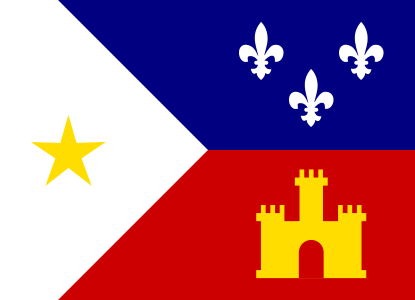
First Côte de Acadiens Communities
(First Acadian Coast - Present Day St. James Parish)
Côte de Acadiens
Use the links or Click any picture to see it in full size
Contents
St. Jacques de Cabahannoce Church - Est. 1750/1757St. Jacques de Cabahannoce Church and Cemetery Original Grounds
St. Michael the Archangel Catholic Church - Est. 1809
St. Gabriel Catholic Church - Est. 1767
St. Jacques de Cabahannoce is the original site of what has historically been known as the first:
Côte de Acadiens, (Acadian Coast)
.
St. Jacques de Cabahannoce (St. James Parish) on the
Côte de Acadiens
Original 1764 - 1768 Acadian Coast Landing Site: Present Day
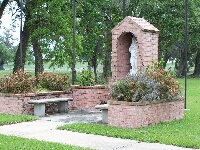
|
|
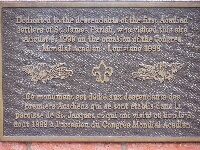
|
||
| Acadian Memorial Click here for a full size image |
|
Click here for a full size image | ||
With the immigration of the Acadians into the Acadian Coast Area of Louisiana, Church Parishes were established at St. James in 1767, at St. Gabriel in 1769, at Donaldsonville in 1772, at Baton Rouge in 1792, and at Plattenville in 1793.
First Acadian Church Communities formed in
Côte de Acadiens
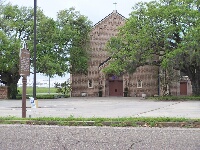
|
|
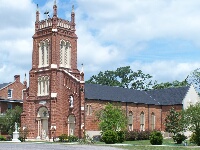
|
||
| St. Jacques de Cabahannoce Click here for a full size image |
|
St. Michael the Archangel Click here for a full size image |
||
|
|
||||
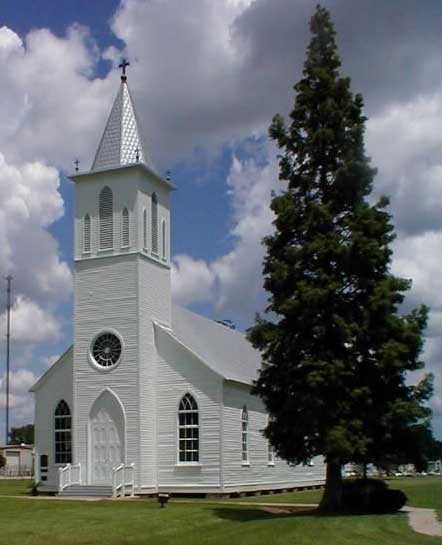
|
|
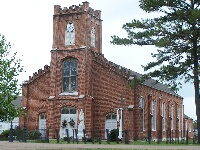
|
||
| St. Gabriel the Archangel Click here for a full size image |
|
Assumption Catholic Church Click here for a full size image |
||
St. Jacques de Cabahannoce
(St. James Catholic Church)
The St. James Catholic Church is located on the west bank shores of the Mississippi River opposite of Convent, Louisiana.
The St. Jacques de Cabahannoce Parish was established between 1750 and 1757. Organized in 1750, the first documented ceremonies to be found are from the year 1757 for which the technical establishment date is given.
The first actual worshiping structure was built in 1770. The St. James church was known as St. Jacques de Cabahanoce when it began. Cabahannoce was an indian term meaning "mallards' roost". In 1770, the small wooden chapel, St. Jacques de Cabahanoce Church, opened its doors to Catholic settlers along the Mississippi River near presentday Vacherie. The importance of the river to the community has always been paramount. Many arrived at their New World home via the river, some traveling downriver from as far north as Canada escaping the Le Deportation (1756 - 1764), and others who spent a decade in imprisonment and exile, primarily from Maryland and other New England states (1765 - 1768), France, Spain, and Canada (1768 - 1785), traveling upriver entering at the mouth of the Mississippi River via the Gulf of Mexico.
The little church was renamed St. James Catholic Church in 1804. Soon after, as sugarcane plantations began to spread in the area and the population increased rapidly, the small church was replaced by an elaborate, three-steepled, cypress-and-brick Romanesque structure that stood high above the Mississippi River. There were no continuous levees along the river at the time. As homes were built, crops planted, and plantations opened, each property owner would build and maintain his own levee. These levees were maybe six feet high and not very strong. The church, therefore, was built directly on the banks of the River and was subject to seasonal flooding.
|
Two statues in the current St. James Church of Mary - The patron saint of the Acadians |
|||
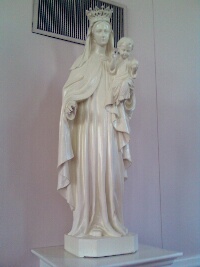
|
|
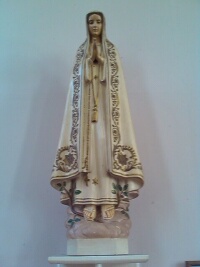
|
|
| Click here for a full size image |
|
Click here for a full size image | |
By the early 1800's, the modest wood frame church could no longer hold the Acadian worshippers who gathered to give thanks to God that their dark days of exile and deportation were finally over. The first church was replaced in 1841 by a fancy brick structure with 3 steeples. The first stone of a new church was laid on February 23, 1840 and consecrated May 1, 1841 by Bishop Blanc in the presence of the Acadian community. The new church was described as being of extraordinary beauty and a masterpiece of architecture.
In the late 1800s, state and national interests resulted in the first organized building of levees along the river. Erosion of this levee resulted in repositioning the levee in 1919. This levee passed so close to the front of the building, the St. James Church parishioners could step from the front door onto River Road which lay at the foot of the levee. The church was too near to the river to be safe. With further erosion affected the church's architectural support, the building was condemmed and plans for a new church arose in the midst of the construction of a new levee system.
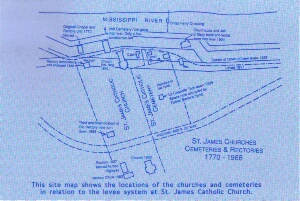
The new levee, still standing, passes squarely through what was the center aisle of the church. A new church, the present-day building, was built in 1930 using wood from the previous church. The relocation of the levee and the River Road has resulted in the loss of the old cemetery through erosion into the Mississippi River and the location of a front gate at what was the back of the old cemetery.
| The cemetery now located across the road dates from the original church. Over the years the cemetery has lost many graves to the river. But there still remains many of the old graves of the original Acadian settlers and plantation owners. |
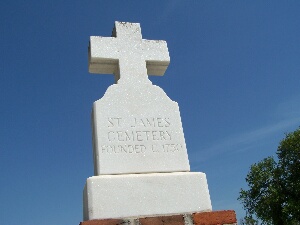
|
|
| Click here for a tour of the St. James Cemetery | ||
St. Jacques de Cabahannoce Landing Site
(site of the original grounds of the
St. Jacques de Cabahannoce Church and Cemetery)
The first set of pictures are views of the site of the original St. Jacques de Cabahannoce Church and Cemetery. Most of the Acadians who were exiled to the Maryland, Pennsylvania, Virginia, South Carolina, Massachusetts, France and England areas found refuge here on the banks of the Mississippi primarily in the years 1764 - 1785.
Present Day
The following images, taken recently in 2009, are present day pictures of the original site where our exiled Acadian ancestors landed between 1764 - 1785 to begin a new community here in southeast Louisiana.
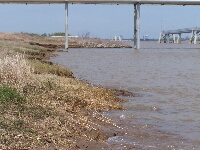
|
|
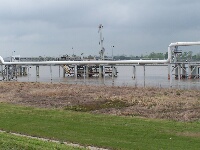
|
||
|
The site of the original church building (in the distance at the rocks) Click here for a full size image |
|
Site of the original church cemetery (in the distance in the grassy area) Click here for a full size image |
||

|
|
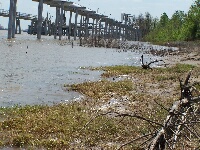
|
Looking out to the site of the ferry that brought Acadian settlers from the east bank and St. Michael's Church to the St. Jacques de Cabahannoce complex on the west bank. Click here for a full size image |
||
|
Looking out to the site of the original church building from the original cemetery grounds Click here for a full size image |
|
||||
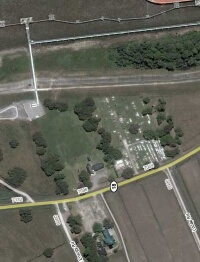
|
|

|
||||||
|
Satellite image of the Present day church building and cemetery grounds Click here for a full size image |
|
Diagram showing the original grounds and changes Click here for a full size image |
||||||
St. Michael the Archangel (St. James Parish - Convent, Louisiana)
More Coming Soon
St. Gabriel Catholic Church - St. Gabriel, Louisiana

Click Here for picture |
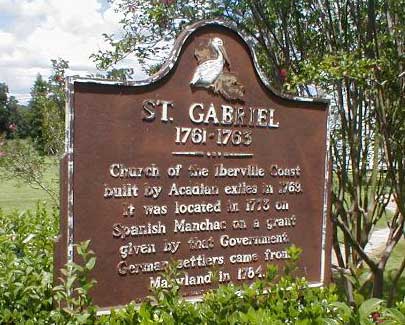
Click Here for picture |
|||
|
There is a secondary marker at the same location; this one is in French: |
||||
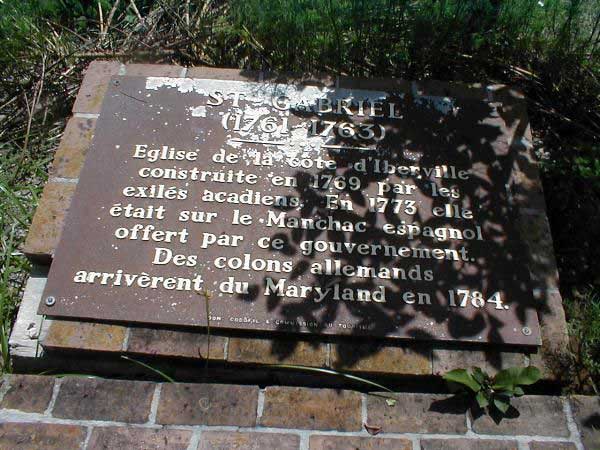
Click Here for picture |
||||
Believed to be the oldest Catholic church structure in Louisiana, St. Gabriel Church has been lovingly restored and maintained by the church congregation. It was built in 1769 and has been moved several times. The steeple of the church, believed to be made primarily of silver, was a gift from the Queen of Spain in 1770. The church is no longer used by the large Catholic congregation in St. Gabriel, but is often the setting for photographs or picnics. It is located on the River Road in St. Gabriel but is not open to the public.
This area is in a part of Acadiana, which was founded by the Acadians, after their expulsion from Nova Scotia in the mid 1700s. St. Gabriel Roman Catholic Church is perhaps one of the oldest churches in the Louisiana Purchase Territory. The church steeple was destroyed by Hurricane Gustav during the 2008 Atlantic Hurricane Season.
The Old St. Gabriel Catholic Church, which appears outwardly to be a fairly typical 19th century Gothic revival church, is in fact a 19th century remodeling of a much older French colonial structure, built by Acadian immigrants from the vicinity of Les Mines in Nova Scotia (Acadie).
The church was built originally on a land grant of one arpent frontage by forty arpents depth issued on August 18, 1767 by Don Antonio Ulloa, governor of Spanish Louisiana. The original site was approximately two miles upstream from the present location of the church, as shown on an undated map in the Biblioteca Nacional in Madrid, which has been estimated to date from between 1767 and 1769.
In 1772 or thereabout, the church was disassembled and rebuilt at a different site. Presumably, this is the present site, although no documentation has been found to prove this. The reasons for the relocation are not known.
The church has been moved back at least three additional times, in 1818 and 1932, all on the present site, as the Mississippi River changed its course, threatening the building. The exact building location of ca. 1772 is now probably somewhere in the river itself.
The church has undergone only one major renovation, in the 19th century, when it was converted from a French colonial building to a Gothic revival building. The date of this modernization is not known; however, church records do refer to a major renovation during the 1887 move, which may have been the date of the Gothic restyling.
In the 19th century renovation, the original hipped roof was changed to a gabled roof, the original bell tower was removed and a new tower built over the west entrance. The original shallow arched ceiling was cut out and a higher vaulted ceiling installed. New turned wood columns were installed to support the ceiling vault and tie rods were installed to prevent the walls from spreading. A 12 foot extension was added at the east end of the church, providing a sanctuary with sacristies on either side. The original windows were replaced with taller arched lancet windows. The original featherboard siding was replaced with clapboards, and the original 1X12 flooring was overlaid with new 1X4 tag flooring.
All of the original woodwork is of cypress, exhibiting a high degree of workmanship in its joinery. Many of the 19th century members are of pine and their joinery is somewhat cruder by comparison.
St. Gabriel Roman Catholic Church is perhaps one of the oldest churches in the Louisiana Purchase Territory and one of the oldest wooden churches along the Mississippi River. Tradition sets the date of the formation of the parish in 1761. According to the 1972 National Register nomination form, the Capuchin Vicar General, Father Dagobert, directed that a church be established in 1769, and tradition has it that the church building was completed in that same year. When Spain took over the administration of the territory from France, the church was dismantled and moved to its present location, approximately 14 miles east of Baton Rouge. A Spanish land grant dates this move from 1772-3, during the administration of Governor Unzaga. The church served an area already settled by French Acadians who had first been exiled from Nova Scotia and then uprooted from Maryland in 1758. It was in this new location, in 1773, that the church was dedicated and placed under the invocation of St. Gabriel the Archangel. The church was later modified between 1850 and 1870. At least four chapels were established under the direction of St. Gabriel Church, as it was the hub of the Catholic Church system of Iberville Parish. These included St. Raphael and St. Paul's in the Bayou Goula area, St. Rose, and the St. John the Evangelist Church in Plaquemine.
The first baptism record available for the St. Gabriel Church is dated April 22, 1773, and the first marriage record is from January 1, 1773. They were recorded by Father Angelus de Revillagodas, a Spanish Capuchin who was at the church at Donaldsonville, a few miles down the Mississippi River. It was not until August 1779, that the French Capuchin, Father Valentin, became the first resident pastor. Two later prominent pastors were Father Cyril de la Croix, pastor from 1859 to 1865, who founded the first Conference of the Society of St.Vincent de Paul in the South, and Bishop Jean Marius Laval, who was at St. Gabriel from 1884 to 1890. Architecturally, St. Gabriel is unique because beneath its 19th-century façade lies an extremely rare18th-century French colonial church building with over 70% of the materials intact. Its exterior is composed primarily of cypress, which remains an abundant material on the site. Its design is Classical on the inside, representative of its French Acadian origins, and its exterior is an example of the Gothic style, which is executed simplistically with its frame construction.
The St. Gabriel Roman Catholic Church is located at 3625 Hwy. 75, in St. Gabriel. It is open by appointment only.


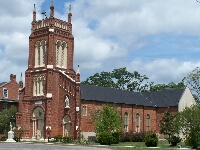
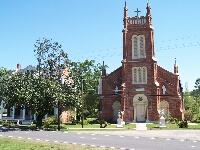
 yahoo.com
yahoo.com